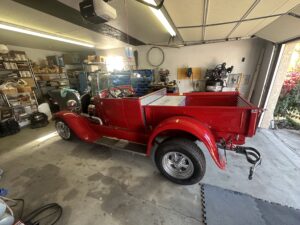
This 1929 Ford Roadster Pick up VIN Verification was done by our team member in Temecula, Ca. on 1-20-2025

This 1929 Ford Roadster Pick up VIN Verification was done by our team member in Temecula, Ca. on 1-20-2025
The 1929 Ford Roadster Pickup is a classic vehicle from the early days of Ford’s vehicle production. Known for its distinctive, compact design and utility, it is a part of the Ford Model A series. A perfect blend of style and functionality, this vehicle gained a cult following due to its versatility and the increasing demand for personal vehicles in the late 1920s.
The 1929 Ford Roadster Pickup was introduced as part of the Ford Model A range, which succeeded the Model T. The Roadster Pickup, designed as a small commercial vehicle, combined the simplicity of the Model A with a functional cargo bed, offering small businesses and farmers an affordable and reliable vehicle for transport. Ford’s mass production techniques allowed the 1929 model to be more affordable than many competitors at the time.
The 1929 Ford Roadster Pickup was powered by a 3.3-liter (200 cubic inch) inline-4 engine, delivering about 40 horsepower. This engine was paired with a 3-speed manual transmission. With a top speed of around 65 mph, the vehicle was more than capable of handling both urban and rural roads of the time. It was a practical workhorse, especially with its ability to carry light loads in the cargo bed.
The design of the 1929 Ford Roadster Pickup was simplistic but stylish, with an open roadster body and a compact pickup bed. It featured a durable steel body and wooden components, with a minimalist approach to interior features. The open top roadster style was popular for personal vehicles, while the rear cargo bed allowed for practical transport. A spoked wheel design and basic dashboard controls gave it an authentic 1920s appeal.
The 1929 Ford Roadster Pickup came in a single configuration, but it could be customized with various options for interior trim, color schemes, and accessories like side curtains for weather protection. The vehicle could also be fitted with different tire types or even a rumble seat for additional passenger space, though these were less common.
Safety features on the 1929 Ford Roadster Pickup were minimal by today’s standards. The car was equipped with mechanical brakes, which were often a challenge to maintain and operate efficiently. It lacked modern safety technologies like airbags, ABS, or traction control. However, its relatively low top speed and simple design meant that the risk of accidents was lower, especially when compared to faster or more complex vehicles of the era.
The 1929 Ford Roadster Pickup was quite efficient for its time. It offered fuel economy in the range of 20 to 25 miles per gallon, depending on driving conditions. This made it an affordable option for people looking for a vehicle that could handle both work and personal transportation without excessive fuel consumption.
Compared to other vehicles in the 1920s, the 1929 Ford Roadster Pickup stood out due to its affordability, reliability, and compact design. Competing vehicles from brands like Chevrolet and Dodge offered similar utility pickups but often at higher prices. The Model A’s mass production allowed Ford to offer the Roadster Pickup at a more competitive price point, making it an appealing option for small business owners and rural families.
When new, the 1929 Ford Roadster Pickup was priced around $400. This price was considered affordable for many people at the time, especially given the utility and versatility it provided. Today, these vehicles can command much higher prices depending on their condition and originality, with well-preserved examples selling for anywhere between $15,000 and $30,000 or more at auctions.
While the 1929 Ford Roadster Pickup didn’t earn formal awards as we think of them today, it was highly praised for its affordability, durability, and the role it played in helping Ford maintain its position as a leading automaker. Its impact on the truck and pickup markets during the late 1920s cannot be overstated, as it set the stage for future models that would continue to shape the industry.
Need a VIN Verification? We are licensed to complete the REG 31 form. Call to get your car, truck or motorcycle verified today!
© 2025 QUICK VIN VERIFICATION. All rights reserved.